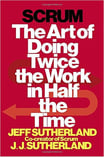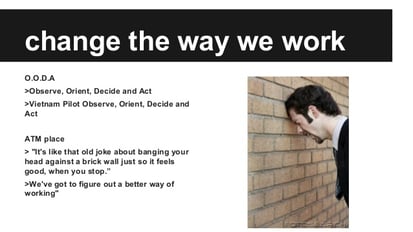In Scaling Up and Mastering the Rockefeller Habits Verne Harnish’s preaches leadership is 1% Vision, 99% Alignment.
This principle is echoed in  Scrum: The Art of Doing Twice the Work in Half the Time by Jeff Sutherland. Sutherland spoke at the Dallas Growth Summit in October of 2015. His book should supercharge your understanding of change and how developing teams using Scrum principles dramatically improves the productivity or your business.
Scrum: The Art of Doing Twice the Work in Half the Time by Jeff Sutherland. Sutherland spoke at the Dallas Growth Summit in October of 2015. His book should supercharge your understanding of change and how developing teams using Scrum principles dramatically improves the productivity or your business.
If your business isn’t aligned from top to bottom you’re not having all your people (oars) pushing you in the right direction. How to change that?
Scrum unequivocally states, companies have two choices: Change or Die.”
My good friend, Alan Fendrich, Advanced Hiring System sent me this video from the The Guitar that shares the impact of change. It’s titled: You Don’t Have Cancer. (Its 56 seconds)
I can’t recommend the movie, but I do endorse the message.
The movie begins with the woman discovering she has inoperable larynx cancer. The doctor tells her she has a month to live. Now late for work, immediately upon arriving her supervisor presents a 4 week severance check. She’s been downsized. She calls her boyfriend. They meet outside his work, but before she has the opportunity to tell him her circumstances, he dumps her.
Pretty depressing!
The rest of the movie is uninspiring, if not narcistic. She abandons her apartment to move to an expensive flat, buys a lot of expensive furnishings, engages in several sexual encounters, purchases a red guitar she dreamed of owning as a child, and maxes her credit line on every credit card. She’s unafraid of the bills; she won’t be alive to pay for them!
That kind of change wasn’t required of my Spontaneous Remission outlined in Bone Marrow Transplant Update last May.
Change Required
Change in business is an absolute requirement. The world is constantly getting more complicated, and the work we do is gaining in complexity at an ever-increasing rate.
Sutherland notes, “How many times do you hear about some massive project costing millions and millions being cancelled not only because of the cost overruns, but because it simply doesn’t work? How many billions of dollars are spent each year producing nothing? How much of your life is wasted on work that both you and your boss realize doesn’t create value? You might as well be digging holes and filling them in again, for all the impact you’re having. It doesn’t have to be this way. It really doesn’t. Just because everyone has always told you that’s the way the world works doesn’t mean they’re right. There is a different way of doing things—a different way of working. And if you don’t do it, you’ll be outsourced. Or your company will die. The hypercompetitive world of twenty-first-century work has no room for waste and foolishness.”
Waste? Sutherland shares the website Healthcare.gov. He shares the Federal Bureau of Investigations failures to produce an institutional knowledge modernization plan. Investing $170 million immediately after 9/11 and then wasting over $405 million from 2005 to 2010 on a program called Sentinel Lockheed Martin promised to deliver. It was scrapped on March 3, 2010 when an independent analysis estimated it would require another 6-8 years to finish plus another $350 Million.
Simplicity
The reason Scrum works is simple. Sutherland looked at how people actually work, rather than how they say they work. Sutherland combed research done over decades, best practices in companies all over the world. He discovered what made the best teams within those companies superior, different, and why some teams achieve greatness while others mediocrity.
The term “Scrum.” comes from the game of rugby. It refers to the way a team works together to move the ball down the field. Careful alignment, unity of purpose, and clarity of goal come together. It’s the perfect metaphor for what Sutherland set out to get teams to do. ALIGNMENT!
Management typically wants two things on any project: control and predictability.  Usually this means vast numbers of documents and graphs and charts. Months of effort go into planning every detail, to avoid mistakes, cost overruns, so things are delivered on schedule. The problem: This scenario never actually unfolds. All the effort poured into planning, trying to restrict change, trying to know the unknowable is a waste of time. Sutherland explains, “Every project involves discovery of problems and bursts of inspiration. Trying to restrict a human endeavor of any scope to color-coded charts and graphs is foolish and doomed to failure. It’s not how people work, and it’s not how projects progress. It’s not how ideas reach fruition or how great things are made.”
Usually this means vast numbers of documents and graphs and charts. Months of effort go into planning every detail, to avoid mistakes, cost overruns, so things are delivered on schedule. The problem: This scenario never actually unfolds. All the effort poured into planning, trying to restrict change, trying to know the unknowable is a waste of time. Sutherland explains, “Every project involves discovery of problems and bursts of inspiration. Trying to restrict a human endeavor of any scope to color-coded charts and graphs is foolish and doomed to failure. It’s not how people work, and it’s not how projects progress. It’s not how ideas reach fruition or how great things are made.”
Management and business needs to change. It’s like the joke about banging your head against a brick wall just so it feels good when you quit.
Why does Scrum work so well? It embraces uncertainty and creativity. It places a structure around the learning process, enabling teams to assess both what they’ve created and, just as important, how they created it. The Scrum framework harnesses how teams actually work and gives them the tools to self-organize and rapidly improve both speed and quality of work. Sutherland explains, “At its root, Scrum is based on a simple idea: whenever you start a project, why not regularly check in, see if what you’re doing is heading in the right direction, and if it’s actually what people want? And question whether there are any ways to improve how you’re doing what you’re doing, any ways of doing it better and faster, and what might be keeping you from doing that.”
Strategic Discipline Mirrors Scrum
This is also why Strategic Discipline works. Priorities, metrics and Meetings are aligned, yet we know that things never go as planned. Meeting rhythms focused on the priorities with red, yellow, green success criteria inform the team when changes must occur. Weekly everyone knows exactly how the company is doing against its priorities.
Scrum provides a valuable summary at the end of each chapter.
Here are Sutherlands summary from the end of chapter #1:
THE TAKEAWAY
- Planning Is Useful. Blindly Following Plans Is Stupid. It’s just so tempting to draw up endless charts. All the work needed to be done on a massive project laid out for everyone to see—but when detailed plans meet reality, they fall apart. Build into your working method the assumption of change, discovery, and new ideas.
- Inspect and Adapt. Every little while, stop doing what you’re doing, review what you’ve done, and see if it’s still what you should be doing and if you can do it better.
- Change or Die. Clinging to the old way of doing things, of command and control and rigid predictability, will bring only failure. In the meantime, the competition that is willing to change will leave you in the dust.
- Fail Fast So You Can Fix Early. Corporate culture often puts more weight on forms, procedures, and meetings than on visible value creation that can be inspected at short intervals by users. Work that does not produce real value is madness. Working product in short cycles allows early user feedback and you can immediately eliminate what is obviously wasteful effort.
What caused the costly mistakes of the FBI’s sentinel system and Healthcare.gov? How did Scrum dramatically impact these bureaucratic nightmares? Why can Scrum help your business? That’s next blog.






.jpeg?width=150&height=135&name=Hand%20with%20marker%20writing%20the%20question%20Whats%20Next_%20(1).jpeg)

